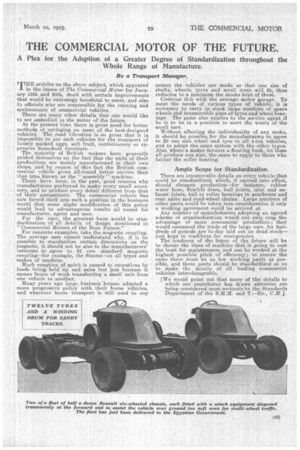THE COMMERCIAL MOTOR OF THE FUTURE.
Page 9

If you've noticed an error in this article please click here to report it so we can fix it.
A Plea for the Adoption of a Greater Degree of Standardization throughout the Whole Range of Manufacture.
By a Transport Manager.
MHE articles on the above subject, which appeared in the issues of The Commercial Motor for January 13th and 20th, dealt with certain improvements that would be extremaly beneficial to users, and also to officials who are responsible for the running and maintenance of commercial vehicles.
There axe many other details that one would like to see embodied in the motor of the future.
At the present time there is great need for better methods of springing on some of the best-designed vehicles. The road vibration is so great that it is impossible to use such vehicles for the transport of loosely packed eggs, soft, fruit, confectionery or expensive household furniture. The majority of British makers have generally prided themselves on the fact that the units of their productions are mainly manufactured in their own shops, and by reason of this fact the British commercial vehicle gives all-round better service than that type known as the "assembly " machine.
There have been, in the past, good reasons why manufacturers preferred to make every small accessory, and to produce every detail different frcm that of their competitors. The commercial vehicle has now forced itself into such a, position in the business world that some slight modification of this policy would lead to advantageous results all round for manufacturer, agent and user. For the user, the greatest boon would be standardization of all details of design mentioned in "Commercial Motors of the Near Future."
For concrete examples, take the magneto coupling. The average user cannot understand why, if it be possible to standardize certain dimensions on the magneto, it should not be also to the manufacturers' interests to agree to fit one standard magneto coupling—for example, the Simms—on all types and makes of machine.
Much vexation of spirit is caused to executives by loads being held up and sales lost just because it means hours of work transferring a small unit from one vehicle to another.
Many years ago large, business houses adopted a more progressive policy with their horse vehicles, and wherever horse transport is still used to any
extent the vehicles are made so that one size of shafts,. wheels, tyres and scroll irons will fit, thus reducing to a minimum the stocks kept of these. Contrast this with the average motor garage. To meet the needs of various types of vehicle, it is necessary to carry in stock large numbers of spare wheels and innumerable sizes of tyres and wheel bearings. The same also applies to the service agent if he i's to be in a position to meet the want* of the small user.
Without affecting the individuality of any make, it should be possible for the manufacturers to agree to fit one size wheel and tyre to all 4-ton vehicles, and to adopt the same system with the other types. Also, where a maker favours a floating bush, let them. all produce one size, the same to apply to those who favour the roller bearing.
Ample Scope for Standardization.
There are innumerable details on every vehicle that could be standardized, which, if carried into effect, should cheapen production—for instance, rubber water hose, flexible discs, ball joints, inlet and exhaust joints, ball or roller bearings in gearboxes and
rear axles and road-wheel chains. Large numbers of other Darts could be taken into consideration if only a working agreement could be arrived at.
Any number of manufacturers adopting an agreed scheme of standardization would not only reap the advantage of more economical production; they would command the trade of the large user, for hundreds of pounds are to-day laid out on dead stock— just kept in readiness for emergencies. The tendency of the buyer of the future will be to choose the class of machine that is going to cost the least for maintenance, and can be worked at the highest possible pitch of efficiency ; to ensure the same there must be as few working parts as possible, and these parts should be standardized so as to make the details of all leading cominercial vehicles interchangeable.
[We would point out that many of the details to which our contributor has drawn attention are being considered most seriously by the Standards Department of the S.M.M. and T.—En., G.M.]




























